Ever tried to spray polyurethane only to find it too thick? Have you wondered if there’s a solution? Let’s dive into the world of thinning polyurethane for perfect spraying!
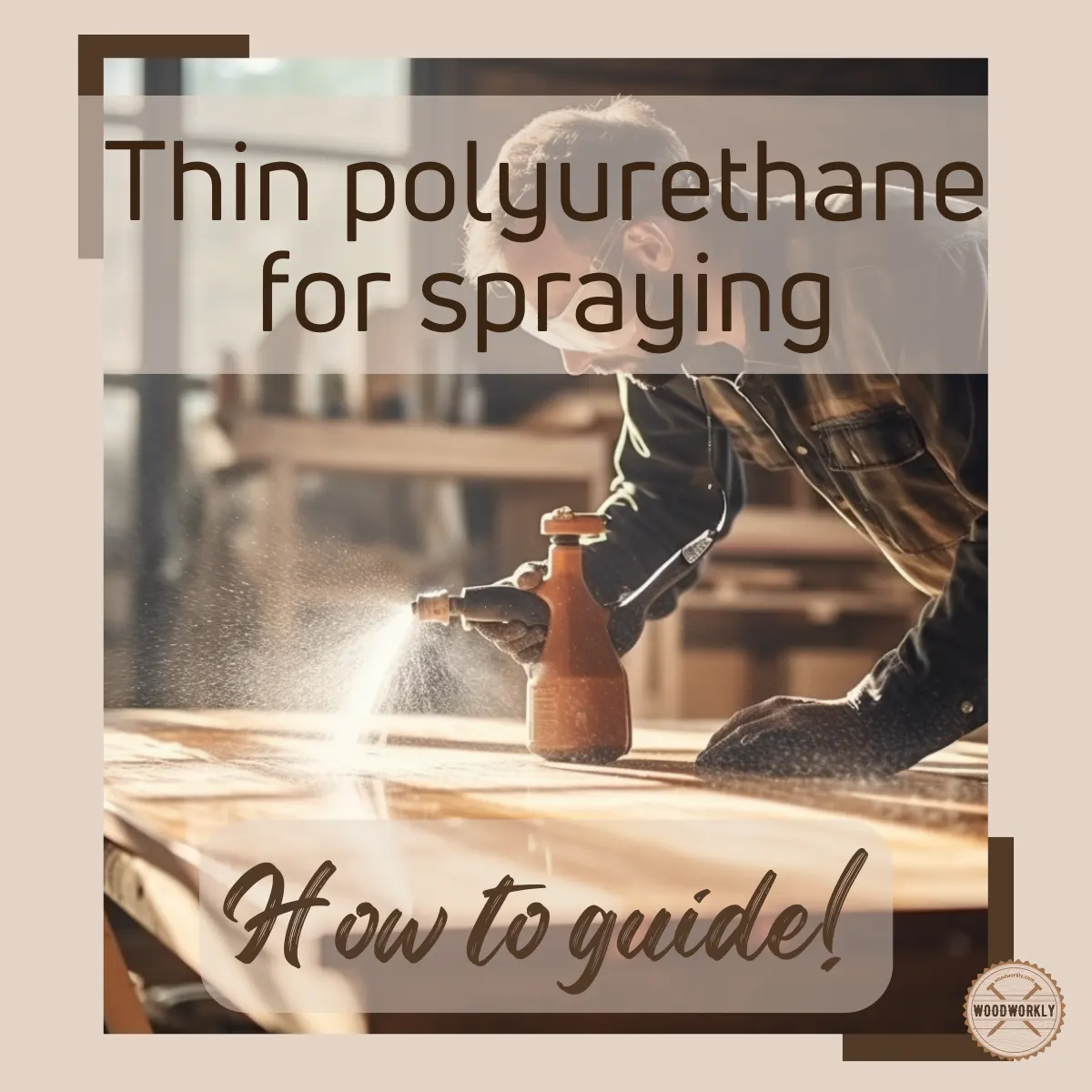
Polyurethane is a wood finish that is used to protect the wood from water damage and scratches while enhancing the natural look of the wood.
You can apply polyurethane by brush or spray.
When I was applying polyurethane by spray, I was curious about thinning it polyurethane before spraying.
I did some research and was able to find out the best technique to thin polyurethane before spraying, which I’m going to share with you.
So, let’s find out, How to thin polyurethane for spraying?
To thin polyurethane for spraying, mix three parts polyurethane with one part mineral spirits or paint thinner for oil-based polyurethane, or water for water-based polyurethane. Stir gently to avoid creating bubbles. Test on a scrap piece of wood before applying to your project to ensure a smooth finish.
There’s a lot more to know about how to thin polyurethane for spraying to get a smooth thin coating as you wish.
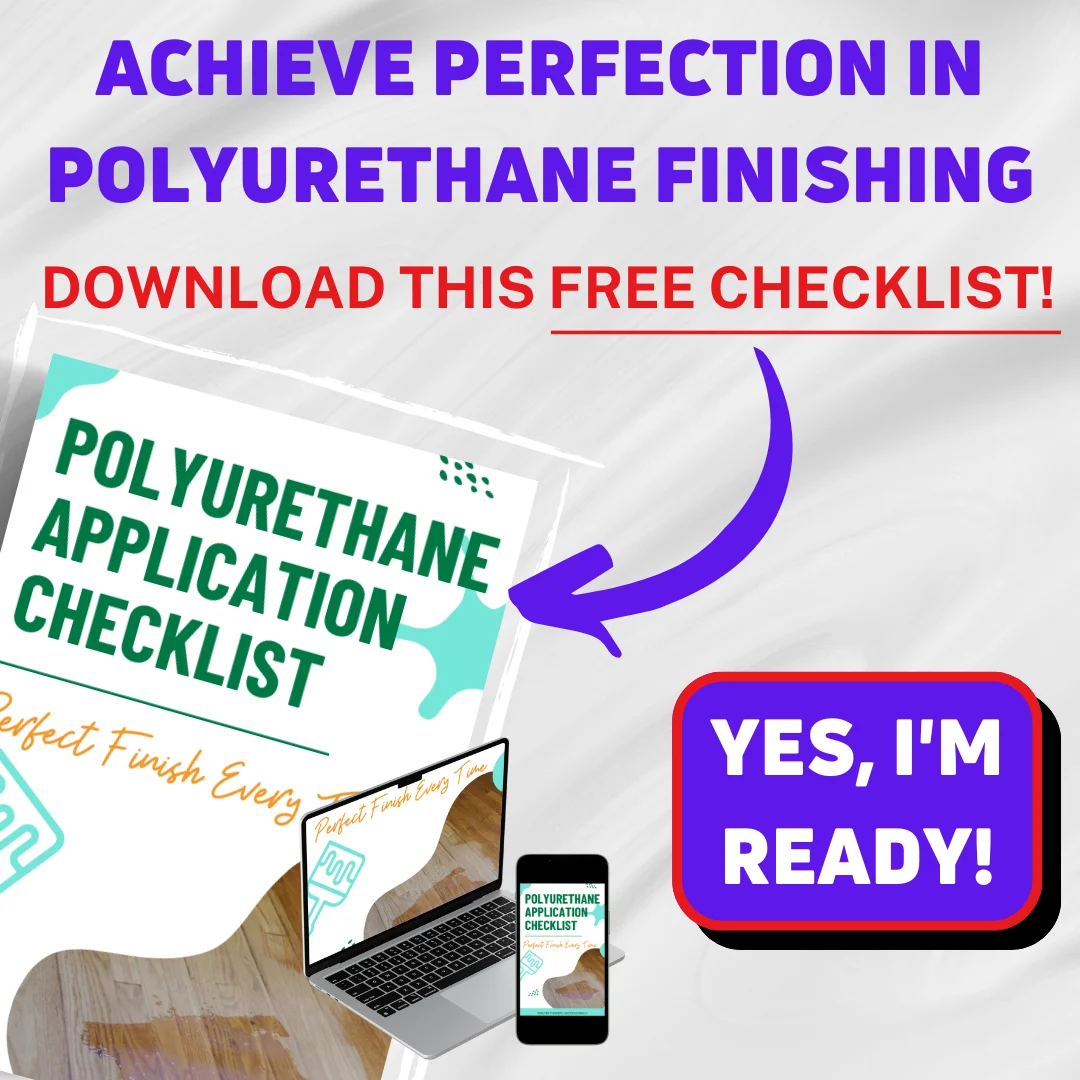
In this article, we’re exploring why thinning is important before spraying polyurethane and how to do that with both water-based and oil-based polyurethane.
Furthermore, I’ll answer some frequently asked questions about polyurethane thinning as well.
So, let’s jump in!

Do You Need to Thin Polyurethane To Spray?
Thinning polyurethane helps you to get an even, nice, and super smooth finish. But it’s not really a necessary thing.
Mostly polyurethane that comes in spray cans doesn’t have to be thinned, because they’re already designed to be as thin as possible.
This will ease the application process. But if the polyurethane doesn’t come in a spray can and you’re willing to spray it, better to thin polyurethane first and then load it into the spray gun or sprayer.
Thinned polyurethane seals the wood way better and prevents from getting surface blotches and streaks.
Thinned polyurethane gives less texture bumps and dries faster and more efficiently than regular polyurethane coatings.
Naphtha, mineral spirit, and other solvents have a high evaporating rate. So, applying a thinner polyurethane will also dry faster because of the quick evaporation.
Rough regular polyurethane is difficult to dry, and the surface can be blotchy easily.
If you’re a beginner in wood finishing stuff, better to work with thin polyurethane to minimize wood finishing issues.
Rough regular polyurethane has high moisture content. Therefore, drying is high and they lay much longer on the surface before drying.
Read to know, Is Polyurethane Waterproof? Here’s the Truth!
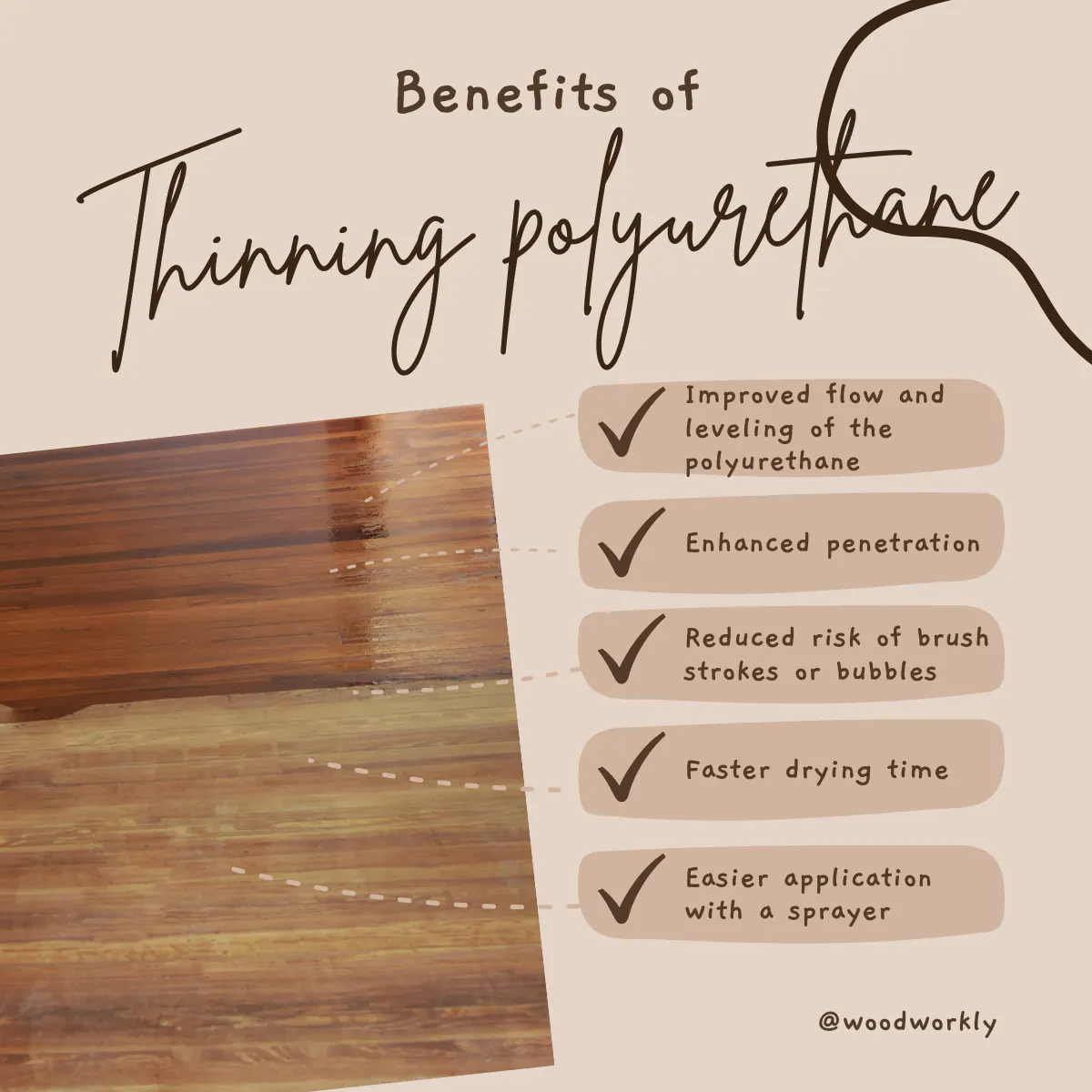
Why Should You Thin Polyurethane?
Here’re the reasons why should thin polyurethane before spraying,
- Thinned polyurethane is easy to apply
- Thinned polyurethane dries faster
- Thinned polyurethane minimizes wood-finishing mistakes
- They prevent the wood from getting a blotchy surface
- Avoid getting tacky or sticky surface
- Able to do the wood finishing quickly and efficiently
Thinning polyurethane isn’t just a whimsical step in your DIY project, but a strategic one. Here’s why:
Firstly, thinned polyurethane is easier to apply, especially on intricate designs and large surfaces. Just like painting a detailed armoire, a thinned solution ensures a smooth, streak-free finish.
Secondly, it contributes to a more uniform final look. Thinning reduces inconsistencies, just as you’d want a lump-free batter for perfect pancakes.
Thirdly, it allows better wood penetration. This is vital for outdoor items exposed to weather extremes, like a wooden deck.
Read to know the Best Exterior Polyurethane (Tested & Reviewed!)
Thinned polyurethane, penetrating deep into the wood grain, can stand up better to the elements.
From personal experience, I once restored an old oak bookshelf. The thick polyurethane gave a streaky finish, but thinning it resulted in a beautiful, glossy finish that highlighted the oak grain.
Thinning polyurethane might seem like extra effort, but it’s an investment that pays off in the quality of your finished work.
So, the next time you pick up that can of polyurethane, remember the benefits of a little thinning.
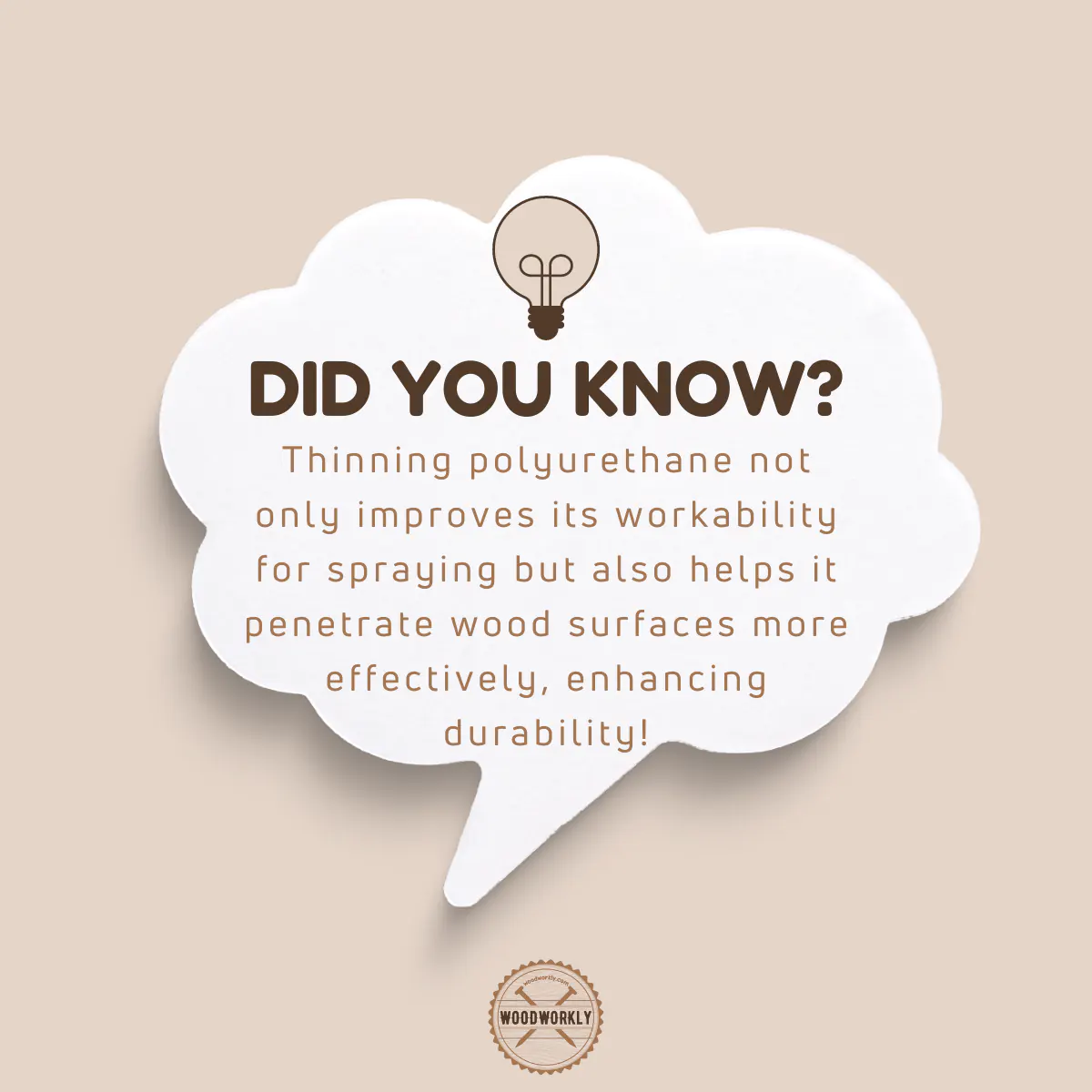
What Can You Use to Thin Polyurethane For Spraying?
Here’re the solvents you can use to thin polyurethane for spraying.
| Oil-Based Polyurethane | Water-based Polyurethane |
| Mineral spirit | Water |
| Oil-based paint thinner | Water-based paint thinner |
| Lacquer thinner | Denatured alcohol |
| Naphtha |
Never use Acetone to thin polyurethane for spraying. Acetone separates polymer from its biner which makes it difficult to stick to the wood properly.
Acetone dries out polyurethane too fast which causes polyurethane to crack with time.
So, let’s find out how to thin polyurethane for spraying. Start with thinning oil-based polyurethane.
To thin oil-based polyurethane, you need mineral spirit, naphtha, or lacquer thinner. They work as a solvent to thin out the polyurethane layer.
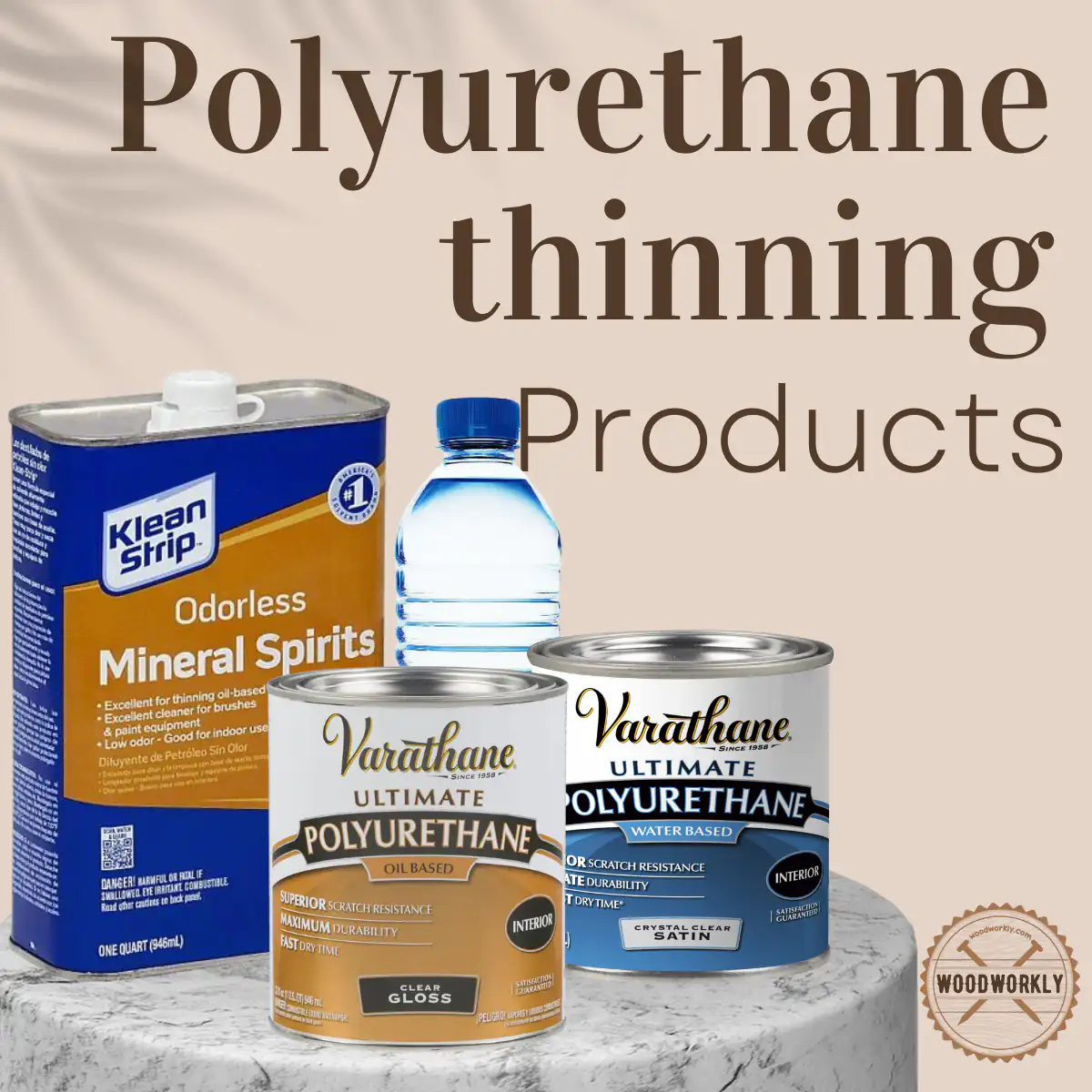
Supplies You Will Need To Thin Oil-Based Polyurethane
Here’re the requirements you need to have before thinning oil-based polyurethane for spraying.
- Polyurethane
- Mineral spirit or paint thinner
- Glass jar
- Clean stick for mixing
- Clean rags
- Spray gun or sprayer
How To Thin Oil-Based Polyurethane for Spraying?
Here’re the steps you should follow to thin oil-based polyurethane for spraying.
- Clean glass jar
- Pour polyurethane
- Add mineral spirit or paint thinner
- Stir the mixture
- Test the polyurethane
- Load polyurethane into the spray gun
So, let’s discuss each of the above steps in detail to get a clear idea about how to thin oil-based polyurethane for spraying.
1. Clean the Glass Jar
The glass jar is better than paint buckets because you can easily see the reaction medium, and you’ll be able to mix polyurethane and mineral spirit incorrect ratio.
Cleaning a glass jar is very much important because it is the place where polyurethane meets the mineral spirit and the reaction happens.
To thin polyurethane by mineral spirit, the reaction should take place in a clean environment without any interferences.
Clean and remove dust, and paints, in the glass jar, using warm soapy water.
You can remove stains and other residues by wiping them off using alcohol.
2. Pour Polyurethane
I don’t recommend you cut the spray can If you’re using polyurethane that comes in a spray can for spraying.
Because spray cans are already designed with thin polyurethane and no need to thin them again.
The polyurethane that doesn’t come in a spray can are recommended to thin before spraying.
So, open the polyurethane can and pour a sufficient amount of polyurethane into the glass jar.
3. Add Mineral Spirit or Paint Thinner
Then add mineral spirit or paint thinner to the glass jar.
When you’re adding mineral spirits or paint thinner to the glass jar maintain the ratio of 3:1 meaning 3 parts of polyurethane to one part of the mineral spirit.
You can use a measuring cup to get the perfect ratio of polyurethane and mineral spirit. Pour ½ cup of mineral spirit into 1 gallon of polyurethane.
To spray polyurethane better use the polyurethane layer as light as possible.
Therefore, adding paint thinner or mineral spirit a little more to the polyurethane can be accepted according to the type of the application.
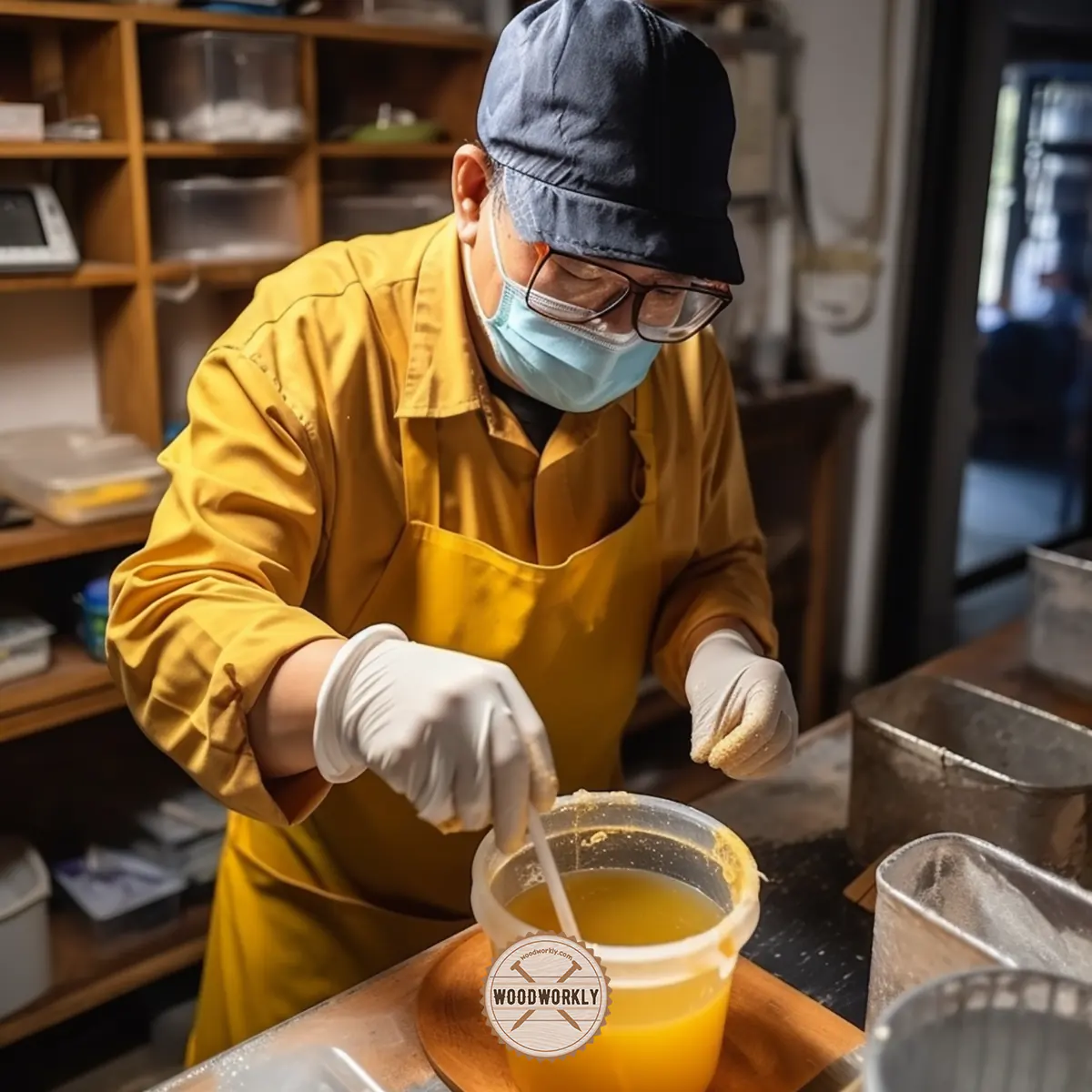
4. Stir the Mixture
Now take the clean stick and stir the polyurethane and mineral spirit mixture for about 10 minutes.
When you’re mixing, make sure to maintain even pressure on the stick and follow the Figure 8 motion of stirring. Stirring too fast can cause bubbles in the polyurethane mixture.
If the air bubbles are trapped inside, it can be a huge problem because they never leave even after the application of polyurethane coatings.
At the end of the stirring mineral spirit-polyurethane mixture, you won’t notice air bubbles. At that moment the thinning process of polyurethane has already been initiated.
5. Test the Polyurethane
After making thinned polyurethane test it on cardboard or a piece of wood with a spray gun. After the application test wait until polyurethane dries to see the true colors.
If the resulting polyurethane layer has no imperfections, no bubbles, or color variations, congratulations, you have successfully thinned the oil-based polyurethane.
- If you feel polyurethane is too thin, add polyurethane a little more to the mixture, stir and do the test again.
- If you notice polyurethane is still too rough, add mineral spirit a little more to the mixture, stir and do the test again.
6. Load Polyurethane into the Spray Gun
Once you are done with thinning polyurethane and the resulted mixture is thin enough, load to the spray gun or sprayer.
At this moment polyurethane is thin and you can achieve a super smooth glossy finish without making any blotches on the surface.
It is so much easy to work with thinned polyurethane than the regular ones because they give excellent results.
That’s how you should thin oil-based polyurethane for spraying.
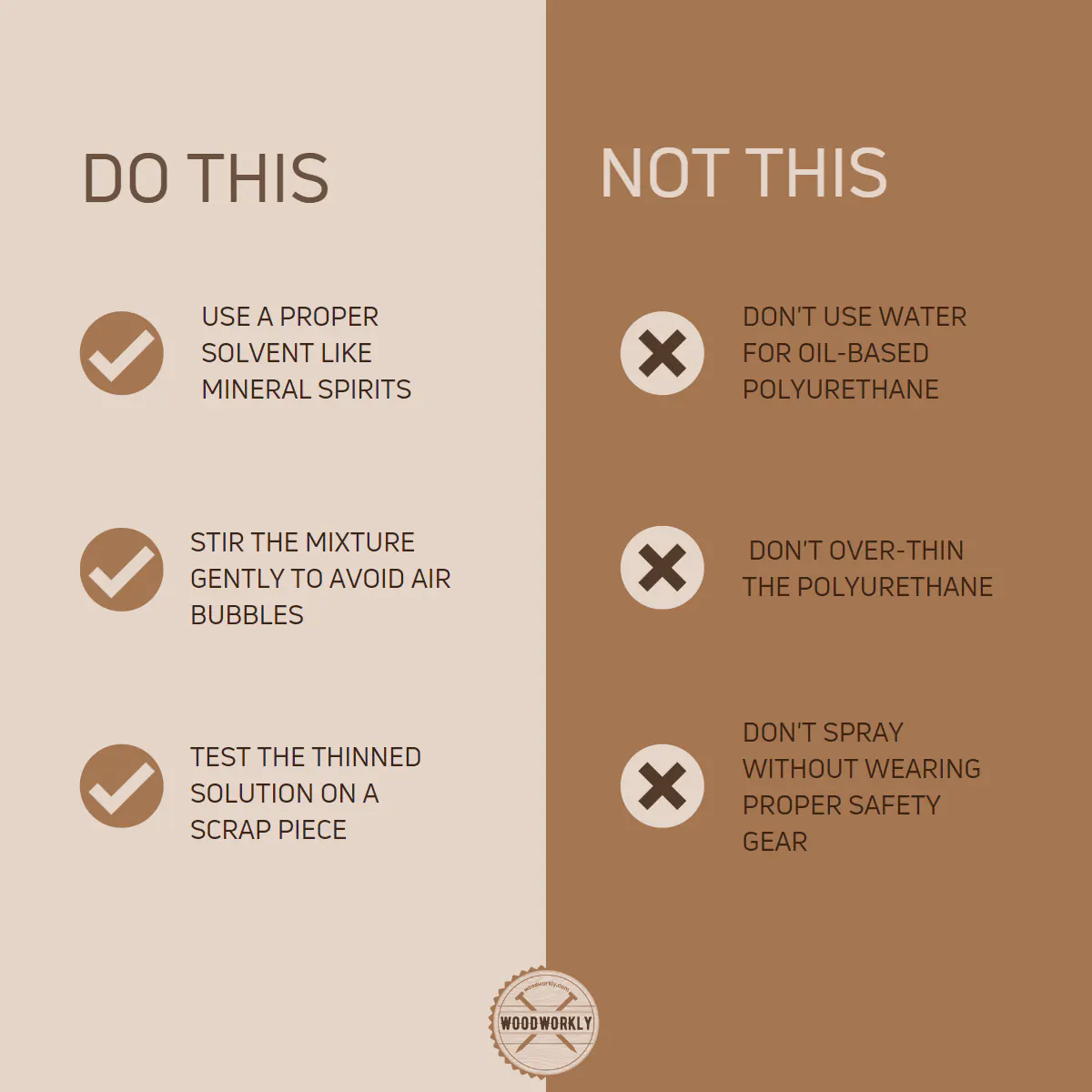
So, let’s find out how to thin water-based polyurethane for spraying.
To thin water-based polyurethane, you need water or denatured alcohol. The amount of water required depends on the application and brands of a polyurethane product.
Supplies You Will Need To Thin Water-Based Polyurethane
Here’re the requirements you should have to thin water-based polyurethane for spraying.
- Polyurethane
- Water or denatured alcohol
- Glass jar
- Clean stick for mixing
- Clean rags
- Spray gun or sprayer
How To Thin Water-Based Polyurethane for Spraying?
Here’re the steps you should follow to thin oil-based polyurethane for spraying.
- Clean glass jar
- Pour polyurethane
- Add mineral spirit or paint thinner
- Stir the mixture
- Test the polyurethane
- Load polyurethane into the spray gun
So, let’s discuss each of the above steps in detail to get a clear idea about how to thin water-based polyurethane for spraying.
1. Clean the Glass Jar
Follow the same procedure as we discussed in thinning oil-based polyurethane for spraying for Jar cleaning.
The cleaning glass jar is very much important because this is where the reaction between water-based polyurethane and water takes place and a clean environment without any interferences is a must.
Clean and remove dust, and paints, in a glass jar using warm soapy water.
2. Pour Polyurethane
Water-based polyurethane that doesn’t come in a spray can are recommended to thin before spraying. So, open the polyurethane can and pour a sufficient amount of polyurethane into the glass jar.
Make sure to take the glass jar that has enough space to contain polyurethane and water.
3. Add Water or Denatured Alcohol
Add water in small increments until it reached the desired amount of thin water-based polyurethane. Add water or denatured alcohol 2% – 3% percent of the total volume.
For example, add 0.4 fluid ounces of water to the 20 fluid ounces of polyurethane volume.
Mostly, the amount of water you should add to the polyurethane has been stated on the polyurethane packaging.
To spray polyurethane better use the polyurethane layer as light as possible.
Therefore, never add 90% of polyurethane to 10% of water instantly which can cause polyurethane too thin.
Adding water slowly while increasing the amount little by little until it meets the best volume to thin polyurethane is the best method to practice.
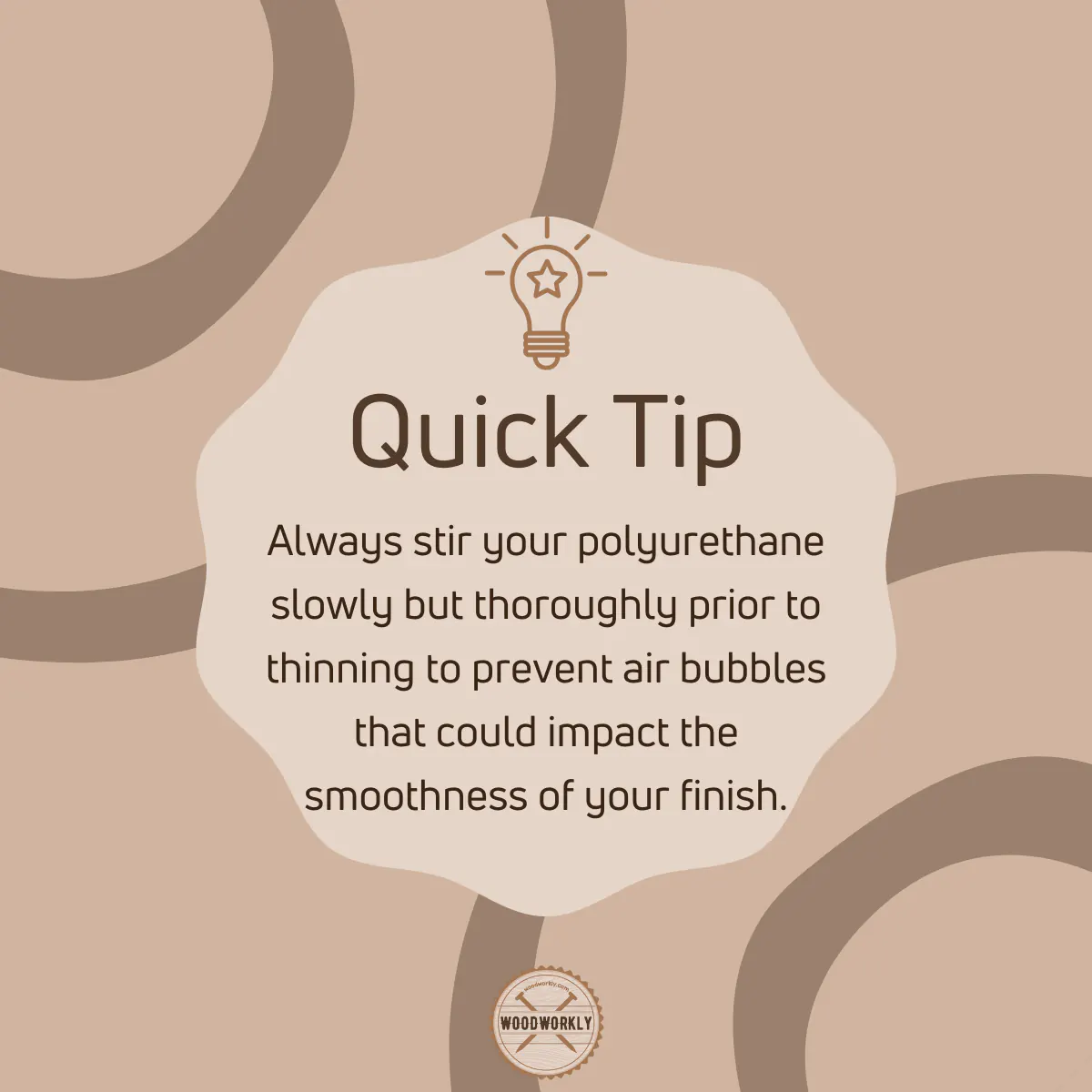
4. Stir the Mixture
Now take the clean stick and slowly stir the polyurethane and water mixture for about 10 minutes.
Never move or stir too fast when stirring. Stirring too fast can cause bubbles in the polyurethane mixture.
Therefore, make sure not to shake the mixture too much when stirring.
5. Test the Polyurethane
After making thinned polyurethane test it on cardboard or a piece of wood by adding a small amount of polyurethane to the spray gun.
After the application test wait until polyurethane dries to see the true colors.
If the resulting polyurethane layer has consistent spray with no imperfections, no bubbles, or color variations, that indicate, you have successfully thinned the water-based polyurethane.
- If you feel polyurethane is too thin, add polyurethane a little more to the mixture, stir and do the test again.
- If you notice polyurethane is still too rough, add water or denatured alcohol a little more to the mixture, stir and do the test again.
6. Load Polyurethane into the Spray Gun
Once you are done with thinning water-based polyurethane and the resulting mixture is consistent and thin enough, load the mixture to the spray gun or sprayer.
To achieve a super smooth surface, you can add a maximum amount of water up to 10% by eventually increasing the water volume by 2% -3%.
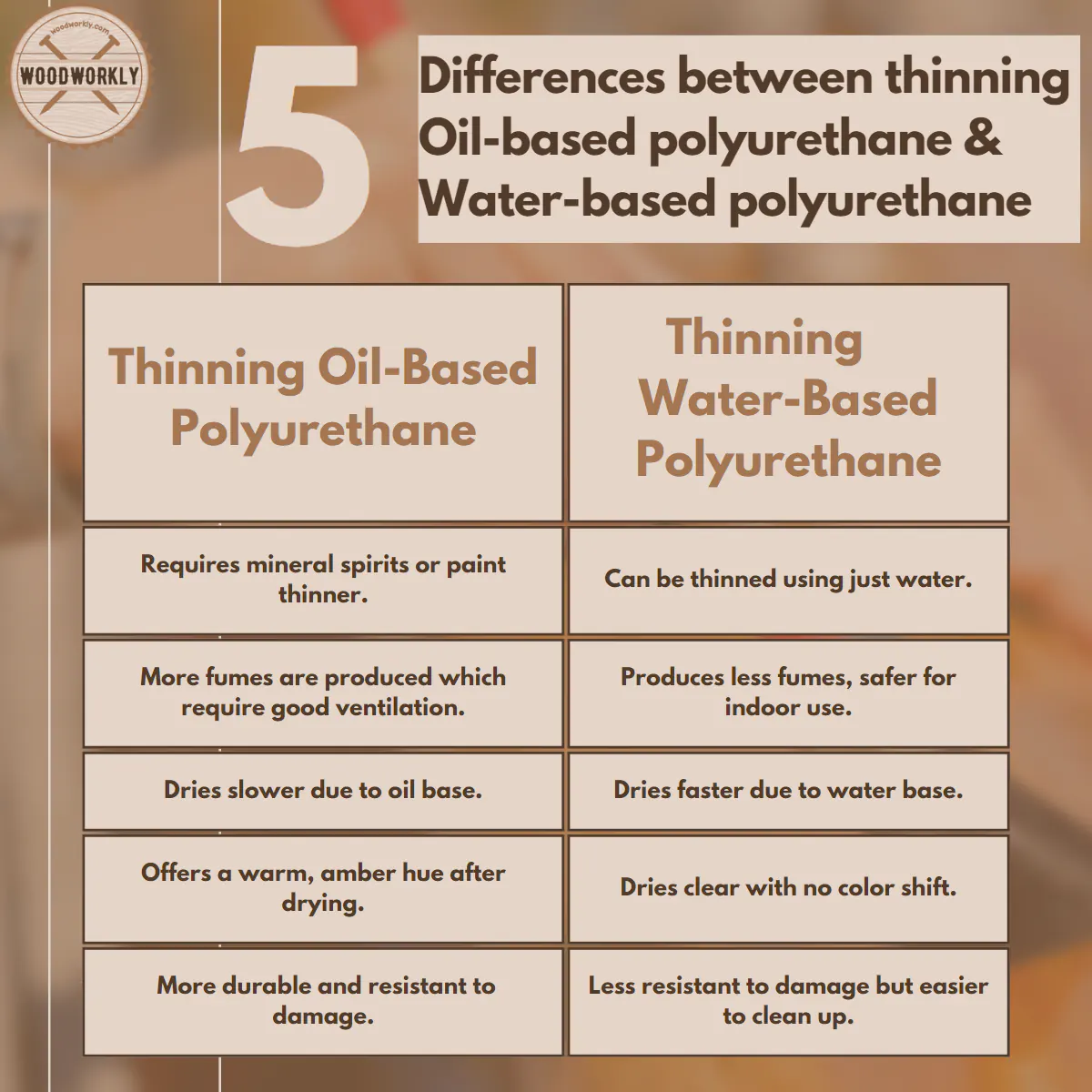
So, that’s how you should thin water-based polyurethane for spraying to minimize getting most of the polyurethane mistakes.
In order to make your process easier, I’ve mentioned some useful tips to follow with the above polyurethan thinning process.
Tips for Thinning Polyurethane
By now, you might be convinced about the benefits of thinning polyurethane. But how do you actually go about it?
Fear not, dear reader, as I’m here to guide you through the process with a handful of tried-and-true tips that have served me well in my own DIY adventures.
Choose the Right Thinner
Choosing the right thinner is as vital as choosing the right paint color.
While it’s possible to use water to thin water-based polyurethane, you’ll need mineral spirits or paint thinner for oil-based polyurethane.
Using the wrong thinner can lead to a complete mess, so always make sure you’re using the correct one.
When I first started my DIY journey, I made the rookie mistake of trying to thin oil-based polyurethane with water.
The result was a clumpy, unusable mess. Lesson learned: Always match your thinner to your polyurethane!
Get the Ratio Right
Once you’ve chosen the right thinner, you need to get the ratio right.
A common rule of thumb is to add thinner to polyurethane in a ratio of 3:1. That’s three parts polyurethane to one part thinner.
However, this ratio can vary depending on the thickness of the polyurethane and the specific application.
I remember working on a detailed wooden mirror frame. I initially used the 2:1 ratio, but the polyurethane was still too thick for the intricate details. I adjusted the ratio to 1:1, and voila! It was just perfect.
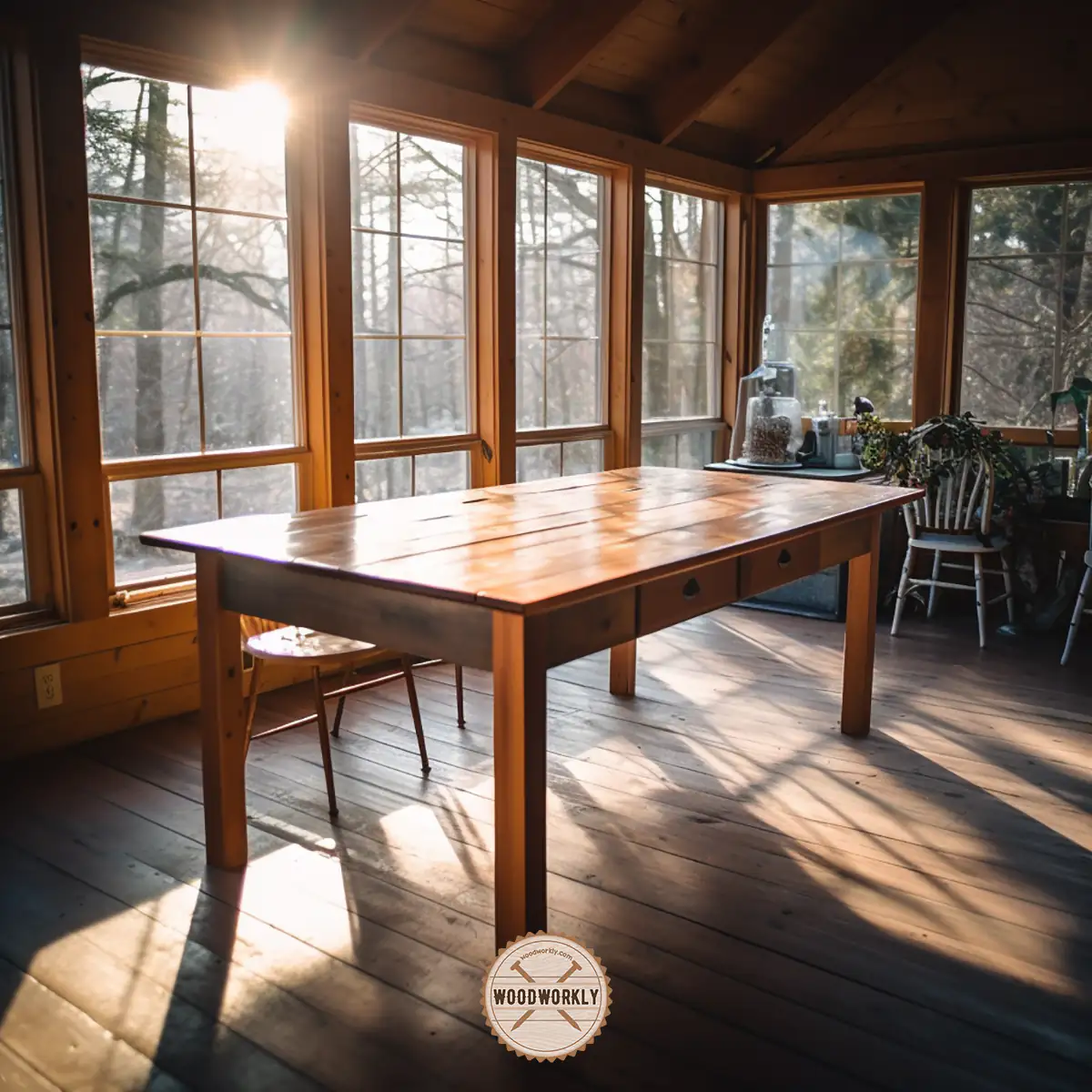
Stir, Don’t Shake
Stirring is your best friend when thinning polyurethane.
Unlike shaking, which can introduce air bubbles and ruin the finish, stirring ensures a smooth, bubble-free mixture.
One of my earliest projects involved restoring a vintage rocking chair. I had vigorously shaken the thinned polyurethane, resulting in a bubbly mess.
The finish was less than stellar, and I had to sand it off and start over. Always stir, never shake!
Test Before Applying
Before you go ahead and slather your thinned polyurethane onto your piece, it’s always a good idea to test it out on a scrap piece of wood first.
This will give you a sense of how it applies and what the finished result will look like.
I can’t stress this tip enough. When I was working on a precious family heirloom—a beautiful mahogany chest—I tested the thinned polyurethane on a hidden spot.
I wasn’t happy with the finish, so I adjusted the thinning ratio until I achieved the perfect consistency.
The final result was a beautifully restored chest that still takes pride of place in our living room.
With these tips in mind and a bit of practice, you’ll soon find it’s a valuable tool in your DIY toolkit.
So, get out there and start experimenting! You might be surprised at how much of a difference thinning can make.
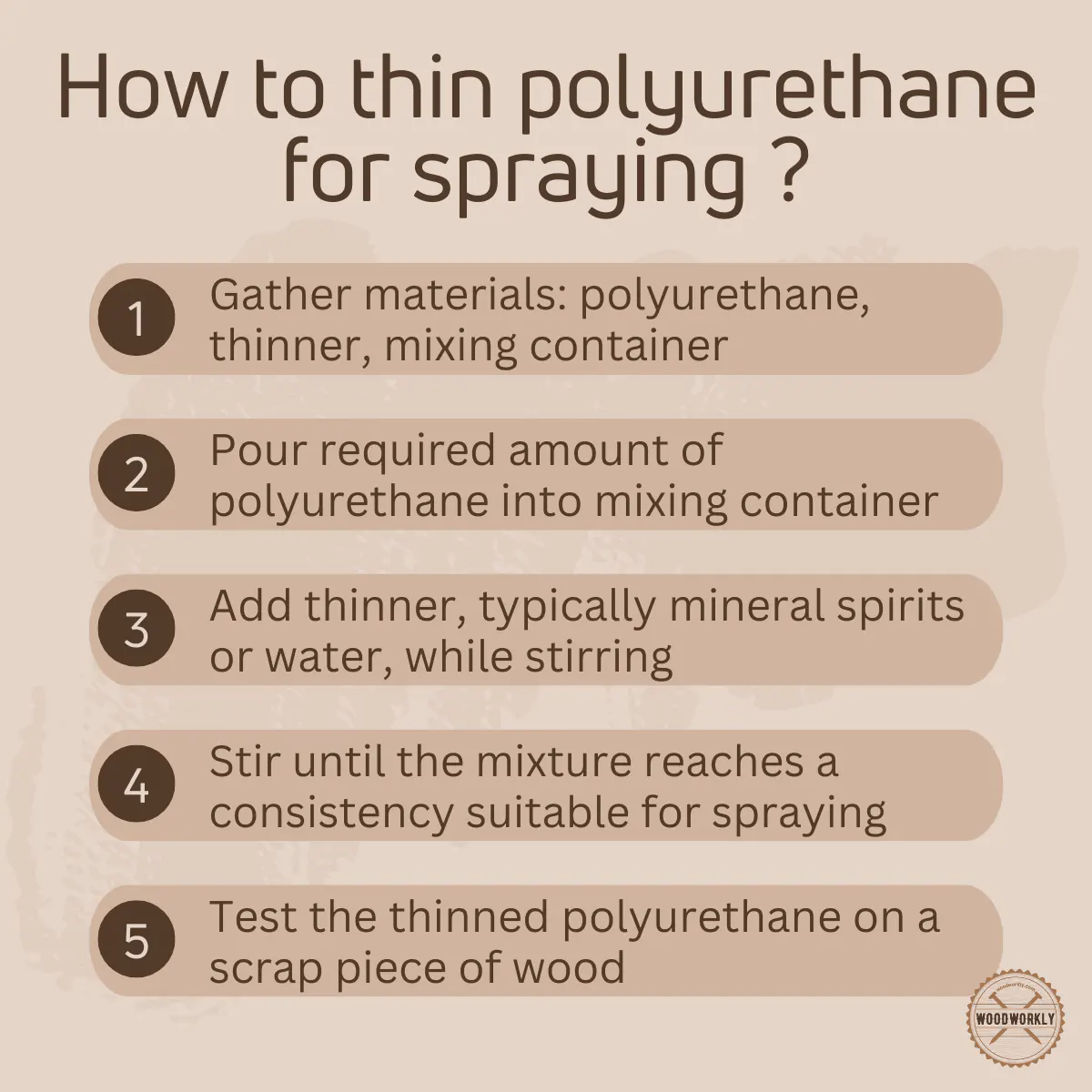
That’s it, folks! hope you were able to everything you wanted to know about how to thin polyurethane for spraying with the right techniques.
Let’s see some related queries about thinning poly for spraying.
How Much Should You Thin Polyurethane for Spraying?
- Oil-based polyurethane should thin by adding 3 parts of polyurethane to one part of the mineral spirit. That basically means you should use oil-based polyurethane to mineral spirit ratio of 3:1
- Water-based polyurethane should thin by adding water in small increments of 2% -3% until it reaches the optimum consistency and increases the adding water amount maximum up to 10% of the total volume. The polyurethane to water ratio differs according to the brands and application type.
What Happens If You Over-Thin Polyurethane for Spraying?
Over-thinned polyurethane never provides what real polyurethane gives to your woodworks or furniture.
There must be a sufficient amount of polymer and binder to stick well to the wood while giving protection to the surface.
Over-thin polyurethane gives the following issues when applied.
- The polymer coat will be too light in color
- Results surface blotchiness after application
- Polyurethane will not stick well to the surface
- Doesn’t provide enough protection against water and scratches
- Results blurry finish
- Poor durability
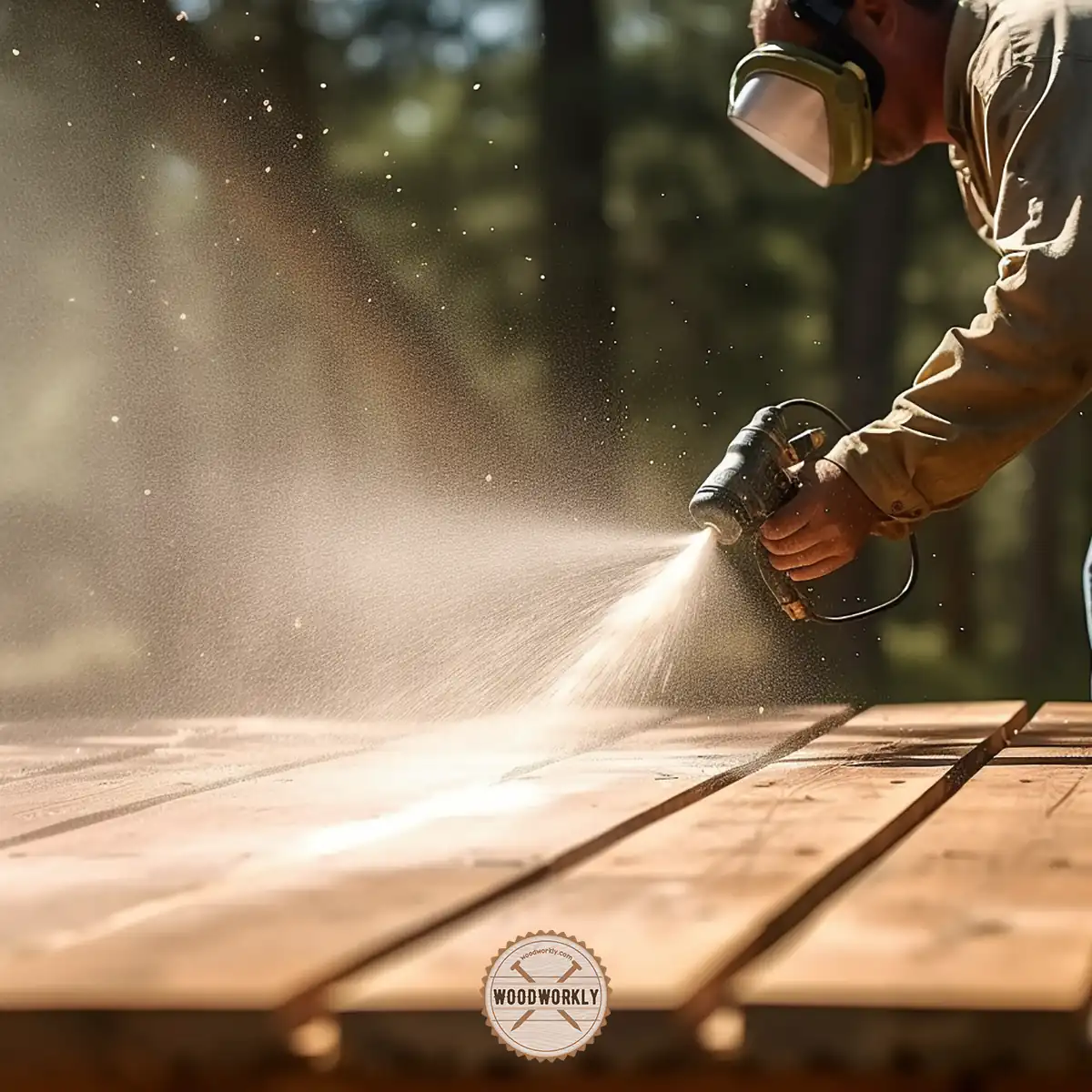
Let’s answer some frequently asked questions as well.
FAQs
What is the main reason for thinning polyurethane before spraying?
Thinning polyurethane enhances its flow, reducing brush strokes and clumps, resulting in a smoother, more professional finish. It also helps the substance to penetrate better into the wood, enhancing the durability and beauty of the finish.
Can water be used to thin water-based polyurethane?
Yes, you can use water to thin water-based polyurethane.
Water is an excellent diluent for water-based polyurethane. It’s important, though, to add it gradually, as too much can make your polyurethane too thin and compromise the finish.
How will I know if my polyurethane is thin enough for spraying?
Look for a consistency similar to milk. If your thinned polyurethane flows easily when stirred and doesn’t leave a trail or “wake” behind, it’s likely ready for spraying.
Are there any risks associated with thinning polyurethane?
Yes, there are. Over-thinning can lead to a weaker finish that might not protect the wood as well as desired. Always remember, it’s better to apply multiple thin coats than one thick one.
Can I use a different solvent other than mineral spirits for thinning oil-based polyurethane?
While mineral spirits are generally recommended, you could also use paint thinner to thin oil-based polyurethane. However, it’s important to remember that different solvents may have varying results, so testing on a scrap piece of wood is crucial.
Is it necessary to thin polyurethane for every application method?
No, thining polyurethane before every application method is not necessary. While spraying typically requires thinning for a smoother application, brushing or wiping might not. The desired finish and the working conditions largely dictate this.
Can you thin polyurethane with mineral spirits?
Yes, for oil-based polyurethane, mineral spirits are the go-to choice for thinning. They dilute the solution effectively, improving its workability without compromising the quality of the finish.
Does thinned polyurethane dry faster?
Yes, thinned polyurethane tends to dry faster due to its lower viscosity, which allows it to spread more evenly and thinly. However, remember that drying times can also be influenced by factors like temperature, humidity, and the type of wood you’re working with.
Did I cover all you wanted to know about: How to Thin Polyurethane For Spraying?
In this article, we have deeply discussed How to thin polyurethane for spraying and why do you need to thin polyurethane to spray with all the tips and techniques.
To thin polyurethane for spraying, mix polyurethane with a suitable thinner like mineral spirits (for oil-based) or water (for water-based) in a 3:1 ratio. Stir slowly to avoid bubbles, then test the spray to ensure proper consistency.
Thinning polyurethane before spraying is not really a necessary thing to do.
But by doing that, I’m 100% sure you’ll get a super smooth even finish than fining with regular rough polyurethane.
Plus, if you’re a beginner in woodworking, I highly recommend o thin polyurethane for spraying to avoid wood facing most of the issues.
We have talked about how to thin both oil-based and water-based polyurethane with different types of solvents and answered some frequently asked questions as well.
Hope you have gained good knowledge about how to thin polyurethane for spraying with this comprehensive guide.
Make sure to practice the steps you have learned in your next wood-finishing project. Keep practicing to become a pro at wood finishing!